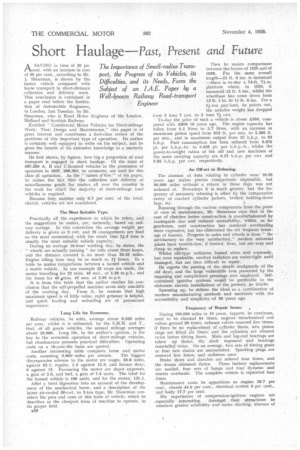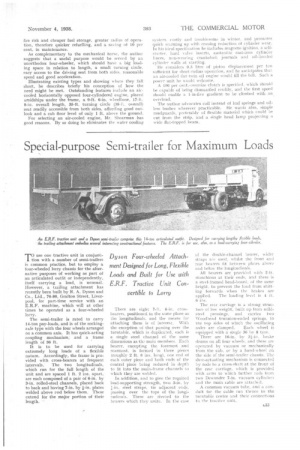Short Haulage Past, Present and Future
Page 50

Page 51

If you've noticed an error in this article please click here to report it so we can fix it.
The Importance of Small-radius Transport, the Progress of its Vehicles, its Difficulties, and its Needs, Form the Subject of an I .A.E. Paper by a Well-known Railway Road-transport Engineer
ASAVING in time of 20 per cent. with an increase in cost of 30 per cent., according to Mr. J. Shearman, is shown by the motor vehicle compared with horse transport in short-distance collection and delivery work. This conclusion is contained in a paper read before the Institution of Automobile Engineers, in London, last Tuesday, by Mr. Shearman, who is Road Motor Engineer of the London, Midland and Scottish Railway.
Entitled " Conaniercial Motor Vehicles for Short-mileage Work: Their Design and Maintenance," this paper is of great interest and constitutes a first-class review of the problems of this important type of operation. Its author is certainly well equipped to write on the subject, and he gives the benefit of his extensive knowledge in a masterly manner.
He first shows, by figures, how big a proportion of road transport is engaged in short haulage. Of the total of 507,256 A, B and C-licensed vehicles in the possession of operators in 1937, 308,383, he estimates, are used for this class of operation. As the " raison d'être ' of his paper, he names the fact that the collection and delivery of miscellaneous goods for traders all over the country is the work for which the majority of short-mileage road vehicles is required.
Because they number only 0.7 per cent, of the total, electric vehicles are not considered.
The Most Suitable Type.
Practically all the experiences to which he refers, and the suggestions he makes, are, naturally, based on railway cartage. In this connection the average weight per delivery is given as 2 cwt. and 25 consignments per load as the most economical, with the result that 21-3 tons is uSually the most suitable vehicle capacity.
During an average 10-hour working day, he states, the " wheels are actually turning" for only about three hours, and the distance covered is no more than 20-25 miles. Engine idling time may be as much as /I hours. In a table he makes Comparisons between a horsed vehicle and a mot& vehicle. In one example 25 stops are made, the motor travelling for 22 mins. 48 secs., at 5.26 m.p.h., and the horse for 40 (mins. 42 secs. at 2.95 m.p.h.
It is from this table that the author reaches his conclusion that the self-propelled machine saves only one-fifth of the working day. From it, he reasons that high maximum speed is of little value, rapid getaway is helpful, and quick loading and unloading are of paramount importance.
Long Life for Economy.
Railway vehicles, he adds, average about 8,500 miles per year, whilst it is estimated, by the S.M.M. and T., that, of all goods vehicles, the annual mileage averages about 16,000. Long life, in the author's opinion, is the key to the economic operation of short-mileage vehicles, but obsolescence presents practical difficulties. Operating costs on a 10-year-life basis are quoted.
Another interesting table compares horse and motor costs, assuming 3,000r miles per annum. The biggest discrepancies adverse to the motor are wages, 56.8 units, against 62.1; repairs, 1.3 against 12.3; and licence duty, 0 against 13. Favouring the motor are depot expenses, a gain of 2.6, and fuel, a gain of 7.3 units. The total for the horsed vehicle is 100 units, and for the motor, 131.1.
After a brief digression into an account of the development of the mechanical horse, and a description of the latest air-cooled 30-cwt. to 2-ton type, Mr. Shearman considers the pros and cons of this form of vehicle, which he describes as the cheapest form of machine to operate, in its proper field.
1316
'Then he makes comparisons between the lorries of 1920 and of 1938. For the same overall length-2l ft. 6 ins, is instanced —there is to-day a 14-ft. 7i-in. platform where, in 1920, it measured 12 ft. 5 ins., whilst the wheelbase has come down from 13 ft. 1 in. to 11 ft. 6 ins. For a 2i-ton pay-load, he points out, the unladen weight has dropped from 3 tons 7 cwt. to 2 tons 7i cwt.
To-day the price of such a vehicle is about £350, compared with £800 18 years ago. The engine capacity has fallen from 5.2 litres to 3.7 litres, with an increase in maximum piston speed from 833 ft. per min. to 2,360 ft. per mm., and in maximum output from 32 b.h.p. to 83 b.h.p. Fuel consumption has been reduced from 0.675 pt. per b.h.p.-hr. to 0.535 pt. per b.h.p.-h., whilst the power-to-weight ratios of the old and new machines of the same carrying capacity are 0.27 b.h.p. per cwt. and 0.85 b.h.p. per cwt. respectively.
An Off-set to Reboring.
The absence of data relating to cylinder wear 10-20 years ago makes precise comparisons impossible, but 90,000 miles without a rebore in those days was not unheard of. Nowadays it is much greater, but the frequency of necessary reboring is offset by the comparative rarity of cracked cylinder jackets, broken holding-down lugs, etc.
Running through the various components from the point of view of maintenance, Mr. Shearman says that in the case of clutches better construction is counterbalanced by inadequate size and reduced accessibility, whilst, as for gearboxes, unit• construction has rendered overhauling more expensive, but has eliminated the old frequent breakage of bearers. Progress in axles and wheels is from " the satisfactory to the very satisfactory," modern universal joints have trouble-free, if limited, lives, but are easy and cheap to replace.
Whilst old-type radiators leaked often and copiously, but were repairable, modern radiators are water-tight until damaged, but are then difficult to repair.
He regrets the passing of the simple mudguards of the old days, and the large vulnerable area presented by the imposing and complicated pressings now employed. Selfcontained iguitiOn systems would be preferable to the elaborate electric installations of the present, he thinks.
Summing up, he defines the ideal as .a combination of modern manufacturing methods and materials with the accessibility and simplicity .of 20 years ago.
Frequency of Repair Items. , During 100,000 miles in 10 years, tappets, he continues, need to be checked 64 times, engines decarbonized and valves ground 30 times, exhaust valves renewed five times; if there be no replacement of cylinder liners, new piston rings are fitted six times; and the cylinders are rebored twice before fitting liners. Main and big-end bearings are taken up thrice, the shaft reground and bearings remetalled twice. On an average, two sets of timing gears or four new chains are necessitated. Sparking plugs are renewed five times, and radiators once.
Brake shoes and clutches are refaced four times, andthe drums skimmed thrice. Three battery replacements are needed, four sets of lamps and four dynamo and starter overhauls. The complete vehicle is repainted four times.
Maintenance costs he apportions as engine 28.7 per cent., chassis 44.6 per cent., electrical system 9 per cent., and body 17.7 per cent.
His experiences of compression-ignition engines are especially interesting. Amongst their attractions he numbers greater reliability and easier starting, absence of fire risk and cheaper fuel storage, greater radius of operation, therefore quicker refuelling, and a saving of 10 per cent. in maintenance.
As complementary to the mechanical horse, the author suggests that a useful purpose would be served by an unorthodox four-wheeler, which should have a big loading space in relation to length, a small turning circle, easy access to the driving seat from both sides, reasonable speed and good acceleration.
Illustrating existing types and showing where they fall short, he describes briefly his conception of how the need might be met. Outstanding features include an aircooled horizontally opposed four-cylindered engine, placed amidships under the frame, a 9-ft. 6-in. wheelbase, 17-ft. 8-in, overall length, 35-ft. turning circle (38-ft. overall) seat readily accessible from both sides, affording good outlook and a cab floor level of only 1 ft. above the ground.
For selecting an .air-cooled engine, Mr. Shearman has good reasons. By so doing he eliminates the water cooling
system, costly and troublesome in winter, and promotes quicic warming up with ensuing reduction of cylinder wear. In his ideal specification he includes magneto ignition, a selfstarter, hard valve inserts, austenitic cast-iron cylinder Ii ners, non-wearing crankshaft journals and oil-tlooded cylinder walls at starting.
He considers 0.5 litre of piston displacement per ton sufficient for short-radius operation, and he anticipates that an air-cooled flat-twin oil engine would fill the bill. Such is power unit he would welcome, A 100 per cent-oversize clutch is specified, which should be capable of being dismantled readily, and the first speed should enable a 1-in-five gradient to be climbed with an overload.
The author advocates coil instead of leaf springs and oilless bushes wherever practicable. He wants also, simple mudguards, preferably of flexible material which could be cut from the strip, and a single head lamp projecting a wide flat-topped beam.




















































































